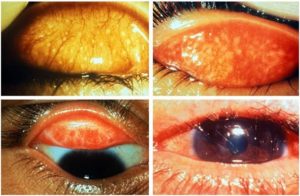
TOP CAUSES OF BLINDNESS WORLDWIDE
In spite of the progress made in surgical techniques in many countries during the last ten years, cataract (47.9%) remains the leading cause of visual impairment in all areas of the world, except for developed countries.

Catarct
Other main causes of visual impairment are:
glaucoma (12.3%)

Glaucomatous cupping of fundus
Age-related macular degeneration (AMD) (8.7%),
Corneal opacities (5.1%)

Corneal opacity
Diabetic retinopathy (4.8%)
Childhood blindness (3.9%)
Trachoma (3.6%)

Trachoma lesions
Onchocerciasis (0.8%).
The causes of avoidable visual impairment worldwide are all the above except for AMD.
In the least-developed countries, and in particular Sub-Saharan Africa, the causes of avoidable blindness are primarily, cataract (50%), glaucoma (15%), corneal opacities (10%), trachoma (6.8%), childhood blindness (5.3%) and onchocerciasis (4%).
Looking at the global distribution of avoidable blindness based on the population in each of the WHO regions, we see the following: South East Asian 28%, Western Pacific 26%, African 16.6%, Eastern Mediterranean 10%, the American 9.6%, and European 9.6%.
In addition to uncorrected refractive errors, these six diseases or groups of diseases which have effective known strategies for their elimination, make up the targets of the WHO Global Initiative to Eliminate Avoidable Blindness, “VISION 2020: The Right to Sight”, which aims to eliminate these causes as a public health problem by the year 2020. Cataract, onchocerciasis, and trachoma are the principal diseases for which world strategies and programs have been developed. For glaucoma, diabetic retinopathy, uncorrected refractive errors, and childhood blindness (except for xerophthalmia), the development of screening and management strategies for use at the primary care level is ongoing at WHO.
Reference : WHO




